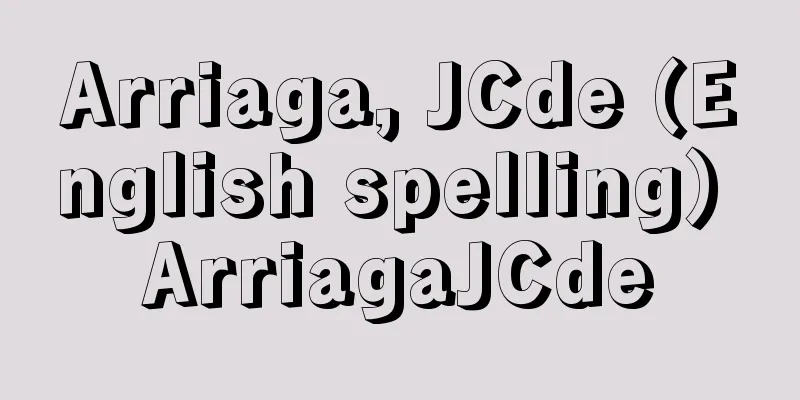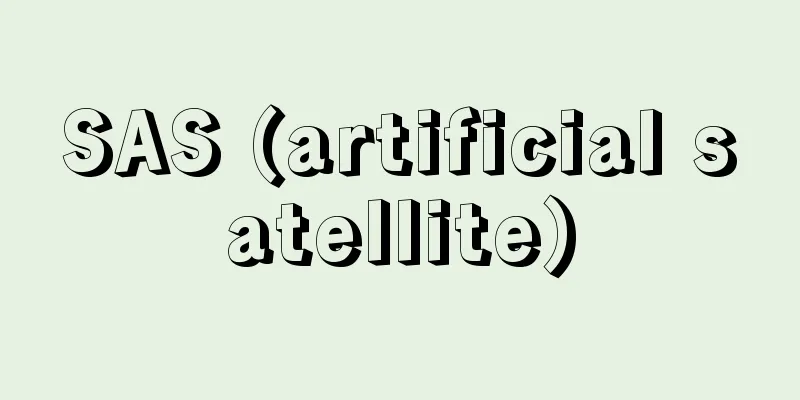Toilet - benjo

|
A building or facility within a building that is used for urination and defecation. In the past, it was called "kawaya." It was also called habakari, setchin, kouka, tosu, and seichin. Nowadays, it is often called a toilet, restroom, or dressing room. Kawaya (lavatory) is written as kawaya or sideya, and it is said that the name came from the fact that buildings for urination and defecation were built on rivers and waste was dumped into the river, or that buildings for urination and defecation were built beside or jutting out from the house. [Hirai Sei] historyJapanHistorically, the earliest concrete example recorded in the Heian Period Daidairi is the construction of an Ohidono (a toilet bowl) in the northeast corner outside the palace. Ohidono is a place where the Hibako (a toilet bowl) was kept. At the Daijoe Ceremony, as recorded in the Engishiki, there was a Otoilet, which was built in the southeast corner at Yukiin and in the southwest corner at Sukiin within an area surrounded by a fence, where the Seiden (main hall) was located. Both were 1 jo long, 8 shaku wide, and 7 shaku high, and had doors. Conversely, examples of toilet bowls being referred to as "okawa" (a portable item used for toilets) can also be seen from the Heian Period. Zen temple architecture, which was introduced along with Zen Buddhism at the beginning of the Middle Ages, also included toilet buildings within the central temple complex. A toilet and bathhouse were located where the corridor that runs east-west from the temple gate turns north; when located on the east side, it was called Toji, and when located on the west side, it was called Saijo. In Zen Buddhism, toilet etiquette is also considered part of training. A toilet from a samurai residence was excavated at the Asakura ruins in Fukui Prefecture, a site from the Warring States period. The toilet, which was set up separately next to the main building, was built on a dug-out basin and had a wooden shuttlecock-shaped "kinkakushi." In the townhouses of medieval Kyoto depicted in the "Rakuchu Rakugaizu" folding screen, there is an independent toilet in a vacant lot in a block of land about one block square, surrounded by townhouses, and it is thought that the people in that block shared this toilet. Entering the Edo period, blueprints have been passed down for samurai residences, including Edo Castle, the shogunate's headquarters, and noble residences, including the Imperial Palace, as well as remains of temple Shakke residences, town houses, and farmhouses. In samurai residences, noble residences, and Shakke residences, urinals and toilets were built as a set attached to the main building. In tenements and offices within the compound, toilets were not provided in each section, but rather one urinal and several toilets were grouped together in small, independent buildings located close together. In early modern town houses, where the passageway extended into the backyard, one urinal and one or two toilets were installed side by side. In farmhouses, it was common to have one urinal and one toilet in a separate building from the main house. In addition, both town houses and farmhouses, when they had a guest room, had a urinal and toilet at the rear of the guest room. In the tenements behind town houses, toilets were not provided for each house, but rather one urinal and several toilets were lined up in one or two places within the block of the tenement. These toilets were called sokouka, and while in Kyoto and Osaka there were doors that spanned the entire width of the frontage all the way up, in Edo the doors were only high enough to hide if you squatted down. In the tea room, a sand hideaway is set up in the garden. In urban homes from the Meiji period onwards, upper toilets were initially installed at the back of the living room, and lower toilets for the family were installed protruding out near the living room, but gradually they came to be incorporated into the building. Structurally they were pit toilets, and nearby farmers pumped the water out to use as fertiliser. From around the Taisho period, septic systems were devised and flush toilets began to be used, but it was after World War II that flush toilets with septic tanks were fully encouraged. Western-style seated toilets also came into use from the Meiji period onwards, but they have only become widespread in recent years. A type of toilet that uses a Japanese-style toilet to save space is the combined urination and urination toilet installed on trains, which came to be known as the train toilet type and began to be incorporated into homes in the Showa period. Western-style toilets are also gradually becoming more popular due to the fact that they can be used for both urination and urination and their health benefits. [Hirai Sei] foreign countryThe use of seat-type flush toilets in ancient Rome has been confirmed at ruins such as Pompeii. In medieval European castles, seat-type toilets were built inside or extending from the walls, and excrement was either flushed into the sewage or discharged directly outside the walls. In the early modern period, for example in the Palace of Versailles in France, seated flush toilets were often built from the early 18th century onwards, but records and stories show that seated toilets and urinals were generally used in palaces as well as among the common people, and that excrement was often dumped in public places such as the street in the morning. Modern flush toilets appeared after water supply and drainage facilities had become fully established in cities, and various ideas for them began to appear, including one patented in Britain in the 20th century. In Europe, seated toilets are the norm, but squat-style Turkish toilets are also used in public toilets and other public places. In China, a type of toilet called "kon" can already be seen on Ming vessels from the Han dynasty. [Hirai Sei] structureDepending on the structure, there are toilets that use the purifying effect of running water, hido-style toilets where feces are collected in a trough box, sand toilets like sand latrines where the waste is purified by covering it with sand and then removed along with the sand, pit toilets which have a separate room outside to use the feces and urine as fertilizer, improved toilets which are an improvement on pit toilets, and flush toilets where waste is purified in a sewage treatment plant. In Japan, squatting toilets have been the norm for a long time, but since the first Western-style toilets were installed in 300 housing complexes in Osaka in 1958 (Showa 33), Western-style toilets have spread rapidly, and 92% of public housing is now Western-style. This influence has also spread to ordinary housing, and some surveys have shown that the ratio of Western-style toilets reaches 55%. Until the 1960s, when Japan was in the midst of high economic growth, flush toilets (water closets, or WCs for short) were considered the ideal toilet, representing a high cultural standard. As they became more widespread, toilets changed from being an "unclean" place in the home and a place to be "embarrassed" by the world to being considered as important as living rooms and bedrooms. In particular, as Western-style flush toilets became more widespread, people began to find the space with a toilet, i.e. the toilet, attractive as a private room, more and more people. Reflecting this trend, new types of toilets are being proposed, such as those equipped with bookshelves or display shelves, or those with shoji screens to create a tokonoma-style alcove. Flush toilets require either a sewer system with sewer pipes and a sewage treatment plant, or a septic tank. Excrement dropped into the toilet is flushed down the sewer each time, and then passed through the sewer to be collected at a sewage treatment plant where it is purified all at once, or it is led to a septic tank where it is purified and then discharged into the sewer, river, pond, etc. Therefore, in areas where such facilities do not exist, it is prohibited by law to install flush toilets. The act of excretion is a highly personal act, and is a necessity at any time, not only for family members but also for guests. For this reason, it is desirable for a toilet to be directly connected to both personal spaces such as the bedroom and social spaces such as the living room. The area required for an adult to defecate is approximately 40cm x 60cm for a Japanese-style toilet and 60cm x 80cm for a Western-style toilet, but the minimum size for a Japanese-style toilet, including the hand-washing sink and paper holder, is generally considered to be 80cm x 100cm and 80cm x 120cm for a Western-style toilet. Western-style seated toilets are the norm for domestic toilets, and flushing methods such as the siphon vortex, siphon jet, and siphon have a large water retention surface area, are less odorous, and are quieter when flushing, but wash-down and flushing types are cheaper but are inferior in terms of performance, such as noise and the size of the water retention surface area. In areas such as holiday homes where the development of sewerage systems and wastewater treatment facilities is lagging behind and where discharge from septic tanks is not permitted, simple flush toilets that require only a small amount of water are used. Also, for cold regions, heated toilets, water draining toilets, and flow toilets have been developed to prevent the water in the toilet bowl and pipes from freezing, but there are still issues to be addressed in terms of reliability, operability, and cost-effectiveness. In recent years, toilet seats have also been modified in various ways. Some have built-in heaters or add functions to blow out warm air, while others spray out warm water when a switch is pressed to clean the toilet. However, while these functions are becoming more and more integrated, concerns have been raised about flush toilets, such as the need to expand sewerage and sewage treatment facilities, the waste of treatment capacity, and water resources. One alternative that has been attracting attention is the dry closet (DC) system. This system uses a drying device to remove moisture from excrement, and the waste is then broken down by bacteria and other microorganisms in the treatment tank. The day when waterless toilets will take over is not far off. [Jin Nakamura] FolkloreOne notable toilet-related custom is the belief in a toilet god, and there are similar practices in China. They are called Senchigami, Kawayagami, or Toiletgami, and when a new toilet is built, in some places a pair of paper husband and wife dolls are buried under the jar as a talisman, or a shelf is set up in the corner of the toilet and a straw doll is enshrined there, and in some places no sacred object is placed there, just a measuring cup and an incense holder. In Chikusei City, Ibaraki Prefecture, June 26th is called Chiyozu Bagion, and udon noodles are made as an offering to the toilet god, and on that day a paper female doll is made as an offering. The toilet god is closely related to childbirth, and there is a popular belief throughout the country that if a pregnant woman cleans the toilet often, she will give birth to a beautiful child. In Miyagi Prefecture, it was believed that if a servant doll (a Tsutsumi doll) was made and placed in the corner of the toilet, the toilet would always be kept clean. From the Kanto region to the Koshinetsu region, on the day an infant goes outside for the first time, a ritual called "toilet visit" is held. People visit the toilet god with offerings (washed rice), and in some regions, they visit not only their own toilets but also those of neighboring toilets. [Osamu Takano] "Housing and Toilets" by Masafumi Rika (1983, Kashima Publishing Co.)" ▽ "Let's Lie Down and Eat: A Forgotten Way of Life" by Bernard Rudofsky, translated by Takuji Okuno (1985, Kashima Publishing Co.)" ▽ "The Culture of Pavement and Sewers" by Namiki Oka (1985, Ronsosha) [Reference items] | |©Shogakukan "> Basic structure of a flush toilet The exterior is made of bamboo poles with wooden walls, and the interior is a structure in which a board is placed over a hole dug in the ground, and excrement is stored in the hole below. Milk-filled toilet in the "Mokuki Eshi" Source: Shogakukan Encyclopedia Nipponica About Encyclopedia Nipponica Information | Legend |
|
大小便をするためにつくられた建物、あるいは建物内の施設。古くは「かわや」といった。また、はばかり、雪隠(せっちん)、後架(こうか)、東司(とうす)、西浄(せいちん)ともいった。現在は、トイレ、お手洗い、化粧室などとよぶことが多い。かわや(厠)は、川屋あるいは側屋と書き、大小便をするための建物を川の上につくって排泄(はいせつ)物を川に流したから、あるいは、家のかたわらまたは家から張り出して大小便をするための建物をつくったことから、その名が生まれたといわれている。 [平井 聖] 歴史日本歴史的には、平安時代の大内裏(だいだいり)において、内裏の外の北東隅に御樋殿(おひどの)がつくられているのが具体的に記録に現れる早い例であろう。御樋殿とは、便器のことをさす樋筥(ひばこ)を扱う場所のことである。『延喜式(えんぎしき)』にみられる大嘗会(だいじょうえ)には御厠殿があり、悠紀(ゆき)院・主基(すき)院ともに垣で囲まれた地域の中の正殿のある一画の中、悠紀院では南東の隅に、主基院では南西の隅に建っていた。その規模は、ともに長さ1丈、広さ8尺、高さ7尺で、扉のある建物であった。また逆に、厠の持ち運びできる物として、便器を「おかわ」といった例も、平安時代に認められる。 中世の初めに禅宗とともに伝えられた禅宗寺院建築には、中心となる伽藍(がらん)の中に便所の建物も含まれていた。山門から東西に始まる回廊が北に折れるところに便所と浴室が設けられたが、東側に設けられたときには東司、西側に設けられたときには西浄とよばれた。禅宗では便所の作法も修行とされている。戦国時代の遺跡である福井県の朝倉遺跡では、武家屋敷の便所が出土している。おもな建物のそばに独立して設けられた便所は、掘りくぼめられた溜(た)めますの上に建ち、木製の羽子板形の「きんかくし」が使われていた。『洛中(らくちゅう)洛外図』屏風(びょうぶ)に描かれた中世の京の町屋では、周囲を町屋が取り囲む一町四方の区画の中の空き地に独立した便所があり、その区画の人々がこの便所を共用していたと考えられる。 江戸時代に入ると、幕府の本拠である江戸城をはじめとする武家屋敷、内裏をはじめとする公家(くげ)屋敷に図面が伝えられているものがあり、寺院の釈家(しゃっけ)住宅、町屋や農家の遺構がみられるようになる。武家屋敷、公家屋敷、釈家住宅では、主要な建物に付属するように小便所と大便所が組になって建てられた。屋敷内の長屋や局(つぼね)では、それぞれの区画ごとに便所が設けられることはなく、一つの小便所といくつかの大便所をまとめて、近接した位置に独立した小さい建物を構成することが多かった。 近世の町屋では、通り庭が裏庭にまで及んだところに、小便所一つと大便所1ないし2が並んで設けられた。農家では、小便所一つと大便所一つを、母屋から独立した一つの建物として設けるのが普通であった。そのほか、町屋・農家ともに客座敷を設ける場合には、客座敷の裏手に小便所と大便所を設けている。町屋の裏長屋では、一軒一軒に便所を設けることはなく、裏長屋の建つ1区画の内の1か所か2か所に、一つの小便所といくつかの大便所を並べている。この便所を惣後架(そうこうか)とよんでいるが、京・大坂の上まで間口いっぱいに扉のあるのに対して、江戸では扉の高さがしゃがんで隠れる程度しかない。 茶室では、露地に砂雪隠(すなぜっちん)を設けている。 明治以後の都市住宅では、初め座敷の裏手に上(かみ)便所、居室の近くに突き出すように家族のための下(しも)便所を設けていたが、しだいに建物の中に組み込まれるようになった。構造的にはくみ取り便所で、近郊の農家が肥料としてくみ取っていた。大正期ごろから浄化装置がくふうされ、水洗便所が使われ始めるが、本格的に浄化槽付きの水洗便所が奨励されるようになるのは、第二次世界大戦後のことである。また、明治以降、洋風の腰掛け式の便器も使われるようになるが、普及するのは近年である。和風便器を使って、便所のスペースを節約した形式に、列車に設けられた大小便兼用の便所があり、汽車便式とよばれて、昭和に入ると住宅にも取り入れられるようになる。洋風便器も、大小兼用することができることと健康上の利点から、しだいに広まっている。 [平井 聖] 外国古代ローマで腰掛け式の水洗便所が使われていたことが、ポンペイほかの遺跡で確認されている。中世のヨーロッパの城郭では、城壁の中あるいは城壁から張り出して腰掛け式の便所をつくり、下水とともに排泄物を流すか、城壁の外へ直接排出するようにしていた。 近世になって、たとえばフランスのベルサイユ宮殿では、18世紀の初期から腰掛け式の水洗便所がたびたびつくられていた。しかし、庶民階級はもちろん、宮殿においても一般的には腰掛け式の便器や尿瓶(しびん)が使われていて、朝になると排泄物がしばしば道路のような公共的な場所に捨てられたことが記録や物語からわかる。 近代的な水洗便所は、給排水の設備が都市に完備するようになってからのことで、20世紀にイギリスでとられた特許をはじめとして、さまざまなくふうがみられるようになる。 ヨーロッパでは便器は腰掛け式が一般的であるが、公衆便所その他の公共的な場所では、しゃがむ形式のトルコ式便器も使われている。 中国では、漢代の明器(めいき)にこんとよばれた便所の形式を、すでにみることができる。 [平井 聖] 構造構造形式によって、流水の浄化作用を利用する厠(かわや)、樋筥(ひばこ)で大便を受ける樋殿(ひどの)形式のもの、排泄物を砂で覆い清め、砂ごと取り除く砂雪隠(すなぜっちん)のような砂便所、糞尿(ふんにょう)を肥料とするため戸外に別室を設けたくみ取り便所、くみ取り便所を改良した改良便所、排泄物を下水処理場で浄化処理する水洗便所などがある。 日本では古くから、しゃがんで用を足す和式が主流であったが、公団住宅が1958年(昭和33)に大阪の団地300戸に初めて腰掛け式の洋風便器を設置して以来、急速に普及し、公団住宅のうち92%が洋式になっている。この影響は一般住宅にも及んでおり、洋式の比率は55%に達するとする調査結果もある。高度成長期の昭和40年代までは、和式、洋式にかかわらず、水洗便所(ウォーター・クロゼットwater closet略してW.C.)は高い文化水準を表す理想のトイレと考えられてきた。その普及とともに、便所は住まいの「不浄」の場、世に「はばかる」場から、居間や寝室と同じ重要さで考えられる場へと変わった。とくに、洋式水洗便所の普及に伴い、座る姿勢が楽になり、臭気もさほど気にならなくなったため、便所のある空間、すなわちトイレに個室としての魅力を感じる人が増えてきている。こうした動きを反映し、書棚や飾り棚を設けたり、障子を入れて床の間風に仕上げたものなど、新しいタイプのトイレも提案されている。 水洗便所は、下水管と汚水処理場をもつ下水道か、屎尿(しにょう)浄化槽を必要とする。便器に落とされた排泄物はそのつど下水に流され、下水を通って汚水処理場に集められ、一括して浄化処理されるか、もしくは、浄化槽に導いて浄化したのち、下水、川、池などに流される。したがって、このような設備のない地域では、水洗便所を設けることを法律で禁じている。 排泄という行為は、個人的な要素の強いものであり、家族はもちろん、来客にとってもいつでも必要性を迫られる。そのため、便所は、寝室などの個人的なスペースと、居間などの社会的なスペースの両方に直接結び付いていることが望ましい。成人の大便に要する広さは、和式で40センチメートル×60センチメートル、洋式で60センチメートル×80センチメートル程度となっているが、一般には手洗いシンク、ペーパーホルダーなども含めて、和式では80センチメートル×100センチメートル、洋式では80センチメートル×120センチメートルというのが、トイレの最小規模とされている。 家庭用の便所では、洋風腰掛け便器が主流で、サイホンボルテックス、サイホンゼット、サイホンなどの洗浄方式は、留水面が広く、臭気が少ないうえ洗浄音も静かだが、洗落し式や洗出し式は価格は安いものの、騒音、留水面の大きさなど性能面で劣る。 下水道や汚水処理施設などの整備が遅れており、浄化槽からの放流も認められていない別荘地などでは、少量の洗浄水ですむ簡易水洗便所が用いられる。また、寒冷地向けに、便器や配管の中の水の凍結を防ぐため、ヒーターによる加熱、水抜方式、流動方式の便器も開発されているが、信頼性、操作性、経済性の面で課題が残っている。 近年、便座にもさまざまなくふうが施されるようになってきている。ヒーターを組み込んだり温風が吹き出す機能を加えたものや、スイッチを押すと温水が噴き出して洗浄するものなどである。しかし、こうした機能の複合化が進む一方で、水洗便所は、下水道・下水処理施設の増設、処理能力や水資源の浪費などの点で不安材料が指摘されている。これにかわるものとして注目を集めているのが、ドライ・クロゼット(D.C.)方式である。排泄物の水分を乾燥装置で取り去り、処理槽内のバクテリアなどの微生物で分解させるというもので、水を使わない便所が台頭する日もそう遠くない。 [中村 仁] 民俗便所に関する注目すべき習俗に便所神の信仰があり、中国にも似たような慣習がある。センチ神、厠(かわや)神、便所神などとよび、便所新設の際には、魔除(よ)けと称して紙製の夫婦一対の人形を甕(かめ)の下に埋めたり、便所の隅に棚を設けて藁(わら)でつくった人形を祀(まつ)る所もあり、御神体など置かず、ただ枡(ます)と線香立てぐらいを置く所もあった。茨城県筑西(ちくせい)市では、6月26日をチヨズバギオンといって、うどんをつくって便所神に供えるが、そのとき、紙で女の人形をつくって供える。便所神は出産と深い関係があって、妊婦がよく便所掃除をしていれば美しい子供が生まれるという俗信は全国的である。宮城県では奉公さんという人形(堤(つつみ)人形)をつくって便所の隅に置くと、いつも便所を清潔にしてくれると信じられていた。関東から甲信越地方にかけては、嬰児(えいじ)が初めて外に出る日、「便所参り」ということをする。お散供(さんぐ)(洗米)を持って便所の神にお参りするのであるが、自家だけでなく近隣の便所を拝んで回る地方もある。 [高野 修] 『李家正文著『住まいと厠』(1983・鹿島出版会)』▽『バーナード・ルドフスキー著、奥野卓司訳『さあ横になって食べよう――忘れられた生活様式』(1985・鹿島出版会)』▽『岡並木著『舗装と下水道の文化』(1985・論創社)』 [参照項目] | |©Shogakukan"> 水洗便所の基本構造 竹の柱に板壁を張り付けた外観で、内部は土を掘った穴に板を架け、下の穴に糞尿を蓄える構造である。『慕帰絵詞』 写国立国会図書館所蔵"> 『慕帰絵詞』にみるくみ取り便所 出典 小学館 日本大百科全書(ニッポニカ)日本大百科全書(ニッポニカ)について 情報 | 凡例 |
>>: Editorial rights - henshuken (English)
Recommend
Vinylidene chloride
One of the dichloroethylene derivatives of ethyle...
Palace style poetry - Kyūtaishi
This is a new style of poetry that was written by ...
Stephanodiscus calconensis (English spelling)
…Most of these species are distributed widely aro...
Effigy Mound - Effigy Mound
...This culture developed in the eastern forest r...
Petrogale xanthopus (English spelling) Petrogalexanthopus
…While kangaroos tend to live in groups in open g...
Daikonsou - Daikonsou
...However, the whole plant is sometimes used in ...
Mother Goose's Melody
…In England, they are usually called “nursery rhy...
Insulating pipe - Insulating pipe
...The purpose of the arc horn is to cause a flas...
ETA (Safety) - ETA
… [Fault tree analysis (FTA)] FTA is a method of ...
Carpenter
...Even in areas where wood was scarce and people...
Otedama - beanbag
A toy for young girls consisting of small cloth b...
Agrostis alba (English spelling) Agrostisalba
…[Tetsuo Koyama]. … From [Bentgrass] …[Kitamura F...
Otsu Court - Otsu Court
...At the end of the Edo period, the Hikone Domai...
Vaccinium corymbosum (English spelling) Vaccinium corymbosum
… [Matsui Jin]. … *Some of the terminology that m...
Research meeting - Research meeting
A faction within the House of Peers. Just before ...






![Okawa [Hot Spring] - Okawa](/upload/images/67cfbfa8ac0a5.webp)


